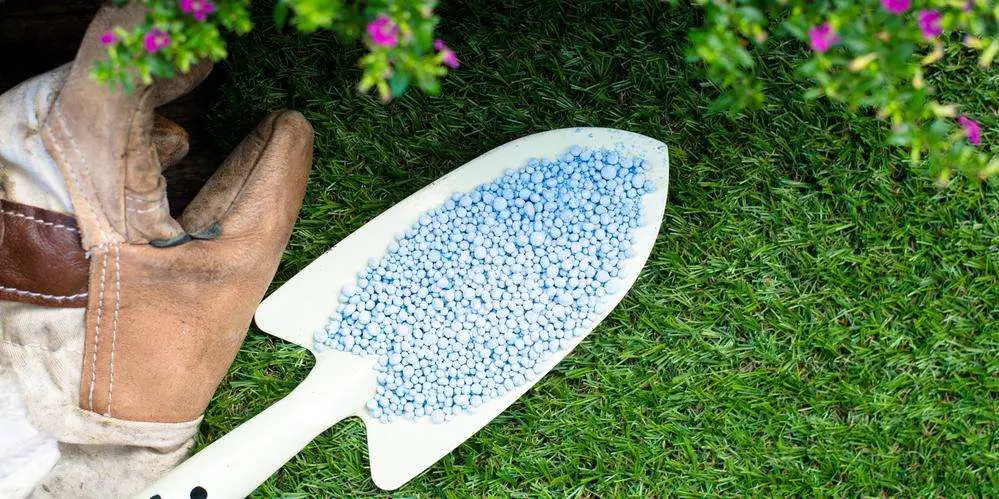How Much To Fertilize
Apply between 2 and 3 pounds of nitrogen per 1,000 square feet each year during the growing season. If you dont use Total Lawn Food, be sure to check to ensure the fertilizer is approved for use on Bermuda, Zoysia or Fescue. Look up our exact fertilizer recommendations per grass in our Lawn Maintenance Guides.
To do the math on specific fertilizer rates for your lawn, visit our blog post on How to Calculate Fertilizer Rates.
Follow the schedules below to ensure youre fertilizing during the appropriate months of growing season.
Can Lawn Fertilizer And Other Treatments Make You Or Your Pets Sick
A number of chemicals in lawn-care products have come under scrutiny in recent years over their potential health impactsparticularly the herbicides glyphosate and 2,4-Dichlorophenoxyacetic acid . Exposure can occur via ingestion, inhalation, or skin contact. And according to the U.S. Centers for Disease Control and Prevention , exposure to large amounts of one or both of the chemicals can result in adverse effects ranging from nausea and vomiting to respiratory issues.
Glyphosate is the main active ingredient in Roundup, which is one of the most widely used weed killers in the world. While the U.S. Environmental Protection Agency foundno evidence that glyphosate causes cancer in humans when it reviewed the available data in a 2020 report, the World Health Organizations International Agency for Research on Cancer classifies the compound as probably carcinogenic to humans. One 2019 meta-analysis of studies on the topic found that exposure to glyphosate was associated with an increased risk of Non-Hodgkin lymphoma, a type of blood cancer, in humans.
Read More: The Modern World Cant Exist Without These Four Ingredients. They All Require Fossil Fuels
Sass adds that there is also concern over organophosphate insecticides, such as chlorpyrifos and malathion, which can damage nerves and cause headaches, sweating, nausea, and muscle tremors. Kind of like having a panic attack, she says. For a pet, they can be lethal.
Best Practices For Fertilizing
Once the grass is established, you can fertilize it following these guidelines:
Also Check: Weedeater Brand Lawn Mowers
Can I Mix Fungicide And Fertilizer
Can I mix fungicide and fertilizer? Tanks mixes can consist of a fungicide and an insecticide to control both a fungus and insects at the same time. Sometimes you may want to mix a pesticide with fertilizer, or mix two herbicides together to increase weed control. . However, unless expressly prohibited by a pesticides label, mixing is legal.
Things You Do After Your First Use Of Lawn Fertilizer

Once you apply fertilizer, you have to keep a few tips in mind. Have a look:
- Avoid using the lawn for at least 24 hours after the fertilization process. Keep away the kids and pets from the grass till you find things dry, and once you find the soil has absorbed fertilizers.
- Avoid mowing for at least two days. The reason is simple: it can hamper the setting of fertilization.
These are basic things to keep in mind once you apply the fertilizer.
Don’t Miss: Nearest Aarons Rent A Center
How To Apply Fertilizer To New Sod
When applying fertilizer to new sod, you should use a broadcast spreader. This will help to evenly distribute the fertilizer over the entire area. Be sure to follow the directions on the fertilizer package in order to avoid damaging the sod.
After you have applied the fertilizer, water it in well. This will help the roots of the sod to absorb the nutrients from the fertilizer.
How Soon You Can Fertilize After Seeding Your Lawn
Its not always after seeding that you should apply fertilizerthe best time to fertilize is right before or during the seeding process. Use a starter fertilizer with quick-release nitrogen since that will give the seeds a nutritional boost. When you make fertilizer a part of the seeding process, your grass will grow quicker and is more likely to end up healthy and lush.
Also Check: Teenage Lawn Mowing Business
Best Time To Fertilize Lawn
Fertilizing in the morning allows the soil to take in the most nutrients, soak in the morning dew and take advantage of cooler temperatures. Thats the best time. Do not apply fertilizer on an abnormally hot day, not even in the morning. Wait until the weather cools back down to a normal temperature.
You can mow anytime after fertilizing with a granular treatment. With a liquid treatment, wait a day or two.
Shutterstock
Why Should You Fertilize New Sod
As soon as youve laid the last piece of sod on your lawn, the work has just begun. While laying new sod gives your lawn a great head start, it is still very fragile and must be cared for properly in order to survive and thrive. One of the most important things you can do for a new sod is to fertilize it.
Recommended Reading: Is It Illegal To Mow Lawns For Money
Time Of Year To Apply Fertilizer
The correct time for you to be applying lawn fertilizer can depend, in part, on the type of grass you grow. People in the northern United States generally grow cool-season grasses, while those living in the South generally grow warm-season grasses. For both types, growers often apply lawn fertilizers in late spring and in late summer. But for cool-season grasses, a third application is often made in late fall.
Your most important feeding for a cool-season grass may well be the one in late fall. This “winterizing” feeding does more than just prepare your lawn for winter: The nutrients supplied will get the lawn off to a good start the next year, in early spring.
When To Apply Fertilizer
The timing and frequency of the fertilization depend upon the types of grass you have in your yard. Generally, we have two types of grass warm and cool-season grasses. Let us check when these common types of grass need fertilizer.
- Warm-Season Grasses These are often found in the southern states, and it is mostly considered during the summer season. The subtypes of these grass include Zoysiagrass, Carpetgrass, Bermudagrass and St. Augustine grass. When it comes to finding the right moment to fertilize them, it all starts during the late spring season when the grass turns lush green. You can even fertilize the grass during the summer season. However, you should avoid fertilizing during the fall season. Fertilizing it too late in the year can make the grass weak during the winter when the grass is dormant.
- Cool-Season Grasses These grasses, including bentgrass, ryegrass, fescue grass and Kentucky bluegrass, grow primarily during the spring season. Hence you have the option to fertilize when the grass is actively growing and especially when you intend to mow it. When you see the temperature dropping during the fall season, it is always a good idea to wait till the first week of May and then fertilize these grasses. Choosing this time will reduce the risk of grass burns due chemical use. However, you should fertilize it for around six weeks before the winter season. Carrying out the fertilization late during the fall can weaken the lawn.
Read Also: When Is Lawn Mowing Simulator Coming Out
How Much Should I Water My Lawn After Fertilizing
How much fertilizer you need is directly impacted by your watering schedule. The more you water your lawn, the more fertilizer it will need. As the grass grows, it uses more nutrients. If you have an automatic sprinkler system, you should fertilize your lawn about every six weeks. You dont want the watering to outpace the fertilizing as that could negatively impact the lawns growth cycle. If you dont have a sprinkler system, you can wait an additional two weeks between applications. Also, be sure to carefully read the fertilizer label to learn whether you should water the lawn before or after applying the product. Granulated fertilizers need moisture to break down after application, while other fertilizers require you to soak the lawn beforehand.
Can You Fertilize Your Lawn Too Much

Its very easy to fertilize your lawn too much. Fertilizing your lawn with too much fertilizer in one application or not allowing enough time between applications, leads to three problems.
As long as you follow the instructions found on the packaging of the fertilizer, the three problems above can be easily avoided.
You May Like: Wild Violets Out Of Control
When To Apply Popular Us Fertilizers
Below is a guide detailing how often to apply popular U.S. lawn fertilizers such as Scotts or Pennington. It also states the key features of the fertilizer. Please note that the table only lists the multi-purpose fertilizers. There are fertilizers available for specific grass types such as St Augustine or Bermuda however, the products below are suitable for all types of grass.
Please note that the table below includes Amazon Affiliate links.
*NPK = Nitrogen, Phosphorous, Potassium
When Should I Fertilize My Lawn In Spring And Fall
As well as knowing how often to apply fertilizer, its also key to know when to apply the fertilizer. To answer this question, it is recommended that you should always follow the instructions found on the label of your chosen fertilizer. However, following the general tips below will help you decide when to fertilize the lawn:
- Apply when the grass is actively growing.
- Apply when the soil is damp and the grass is dry.
- Apply when the grass is frost-free.
- Dont mow the lawn 3 days before or after applying the fertilizer.
Applying fertilizer outside of the period stated on the instructions as well as the guide above will run the risk of damaging your lawn so it is important to pay attention to this.
Dont apply fertilizers to your lawn during the winter months as the grass is dormant and will not achieve any better results. Applying fertilizer in the winter will increase the chance of polluting waterways by excessive run-off of the nutrients into nearby streams.
Also Check: Rabbit Repellent For Grass
Lawn Fertilizer Schedule For Warm
Early spring: When the grass greens up after winter, usually late March or early April depending on the year and where you live
Early summer: When grass growth speeds up, but before the onset of intense midsummer heat, usually early June
Early fall: At least 6 8 weeks before the first expected frost, usually sometime in September
How To Mix & Apply Liquids And Granules: Your Step
If you are adding any additional product, such as a surfactant or spray indicator dye, you would add that product to the sprayer at this point as well. Add the rest of the water and replace the top on the sprayer. Then, shake the sprayer vigorously to thoroughly mix the chemical product and water together. Step 3.
Also Check: John Deere Lawn Tractors Lowes
What Can I Do To Make My Lawn Care Healthier
One guaranteed way to reduce the risk and impact of lawn care is to have less lawn in the first place. That may mean replacing swaths of grass with native plants, or designing landscapes that limit the need for irrigation . Even leaving your grass a bit longer can help, Sass says, If you do less work, the longer lawn will choke out the weeds.
But if you are set on buying lawn-care products to maintain your yard, Ryan Anderson, the community integrated pest management manager with the non-profit Integrated Pest Management Institute of North America, recommends avoiding products with glyphosate, 2,4-D, organophosphates, and neonics. He also says that people buying fertilizer sometimes dont realize that there may be herbicides already mixed in, such as with so-called weed and feed blendsso double check before leaving the store. There are also some lower risk products, such as Fiesta, that he points people to if they insist on applying weed or pest controlthough he warns that they can be expensive.
Sass also suggests that unless someone is a particularly experienced gardener, they can avoid unnecessary complications or accidents by staying away from products that they have to mix themselves from a concentrate. I hope they are buying those products that are ready-mixed, she says. She also adds that, instead of putting mosquito treatments on lawns, people could consider using bug repellent.
How To Fertilise A Lawn
You can fertilise a lawn by hand, but it can be a difficult process as it is hard to tell whether you have put the right amount down. It is generally advisable to use a spreader as most lawn care professionals do because they can help you to spread your fertiliser evenly over the surface and give better results. There are several different types of spreader that you can use. Shoulder or handheld spreaders are good for gardens that are not a standard rectangle shape and are very easy to use. You can also use mechanical push-along spreaders. These spreaders are better for large gardens where you have a lot of fertiliser to spread. Rotary spreaders have a spinning mechanism that throws or sprays the fertiliser while drop fertilisers have small holes in the underside out of which the feed drops onto the grass. Liquid fertiliser can be sprayed directly onto the lawn surface and is good for demand feeding in areas that need more nutrients.
Ideally you should feed your lawn as soon after mowing as possible as this will give the grass more time to absorb the nutrients before the next mow. If you mow your lawn after fertilising you may remove the fertiliser before it has a chance to sink in properly.
Read Also: True Green Prices
Should I Fertilize My Lawn Before Or After Mowing
Ideally, youll want to mow and rake before fertilizing so that excess lawn waste is removed, allowing the fertilizer to have an easier time reaching the soil. Aerating your soil before fertilizing can also help. When fertilizing a lawn, it is best to apply fertilizer after the lawn has been mowed so it has a few days to absorb the fertilizer.
Can You Mix Insecticide With Herbicide

Tanks mixes can consist of a fungicide and an insecticide to control both a fungus and insects at the same time. Sometimes you may want to mix a pesticide with fertilizer, or mix two herbicides together to increase weed control.However, unless expressly prohibited by a pesticide’s label, mixing is legal.. Thereof, can I mix insecticides? Most fungicides and insecticides for home use are …
Also Check: Expert Gardener Lawn Fertilizer 30-0-4
How Do I Know How Often To Fertilize Lawns
If you fertilize too little you wont feed your lawn with the nutrients it needs, and it may turn brittle and yellow. Apply too much fertilizer too early or late, and you can burn the blades.
Most lawns will do fine with fertilizing one or two times a year, in the early spring and the fall, but this depends on the type of lawn you have. Some people do it four times per year. In this case, we recommend keeping in mind the big holidays to do it: around Easter, Memorial Day, Labor Day, and Halloween.
Depending on your lawn, you can fertilize up to once every four or five weeks if using synthetic fertilizers. If you have a slow-release organic fertilizer, you can space out the applications for eight to 10 weeks.
Avoid fertilizing in the peak temperatures of the summer. The heat and blazing sun together with the fertilizers can damage your grass.
Should You Fertilize Before Or After Cutting Lawn
When fertilizing a lawn, it is best to apply fertilizer after the lawn has been mowed so it has a few days to absorb the fertilizer. Wait until late summer, fall or early spring to fertilize the lawn. These are the optimal times to apply fertilizer. Mow the lawn and leave a small bit of grass clippings on the lawn.
You May Like: Humichar Home Depot
Why Use Organic Fertilizer
Organic lawn fertilizer provides vitamins and minerals that your lawn uses to stay lush and green. This specialized variety of fertilizer might include animal proteins derived from processed animal products or waste, potash, seaweed, manure, compost and corn gluten meal.
Organic lawn fertilizer applied two to three times a year can take the place of many artificial treatments depending on the nutrient requirements of your lawn. It is important to remember that fertilizing is only one component of sound maintenance practices for a healthier lawn.
